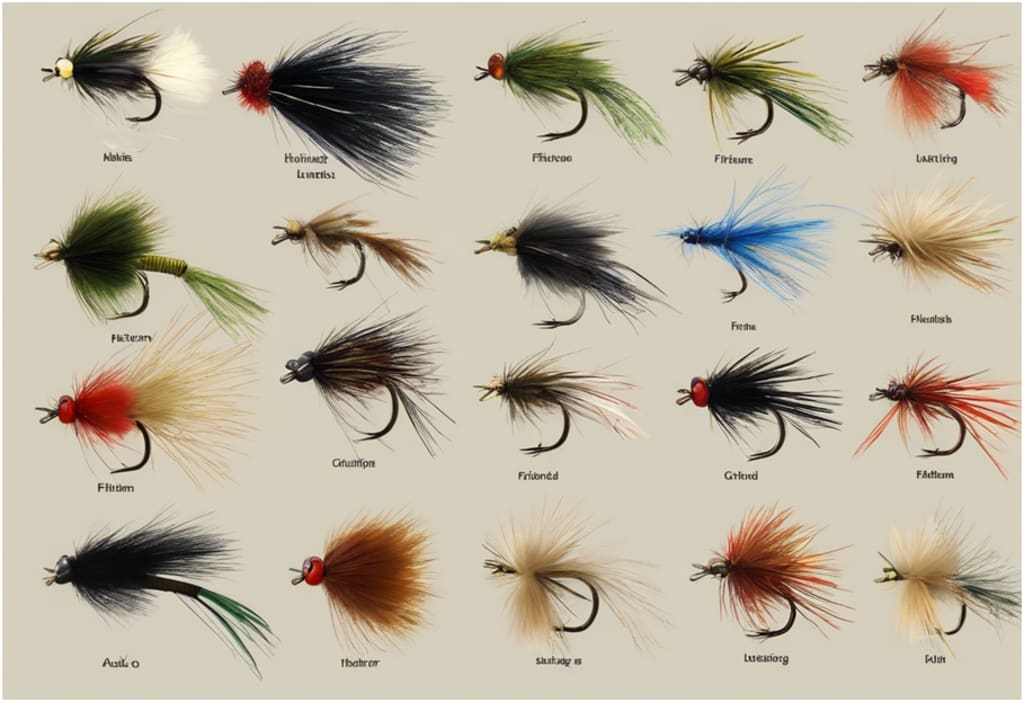Different Kinds of Flies For Fly Fishing
Fly Fishing

Types of flies used in fly fishing
Fly fishing is a popular angling method that involves using an artificial fly to catch fish. The types of flies used in fly fishing play a crucial role in attracting different kinds of fish species. Anglers often use various types of flies based on the fish they are targeting and the fishing conditions. Understanding the different kinds of flies available for fly fishing can significantly enhance your fishing experience and increase your chances of success. In 2023, there were approximately 32.24 million paid fishing license holders in the U.S., down from 30.26 million the previous year.
Dry Flies
Dry flies are designed to float on the surface of the water, imitating insects that land on the surface. These flies are ideal for fishing in calmer waters where fish are feeding on insects at the surface. Common dry flies include mayflies, caddisflies, and stoneflies. Anglers often use dry flies during hatches when insects are emerging, and fish are actively feeding on them.
Wet Flies
Unlike dry flies, wet flies are designed to sink below the water's surface. They imitate insects that are submerged or emerging from the water. Wet flies can represent a variety of aquatic insects, baitfish, or invertebrates that fish feed on underwater. Wet flies are versatile and can be used in a variety of fishing conditions, making them a popular choice among anglers.
Streamers
Streamers are large, colorful flies that imitate baitfish, leeches, or other large aquatic creatures. These flies are designed to mimic the movement of prey fish, making them attractive to predatory fish species like trout, bass, and pike. Anglers often use streamers in fast-moving waters or when targeting larger fish that are actively hunting for prey.
Nymphs
Nymphs are fly patterns that resemble the immature stage of aquatic insects. They are designed to look like fished below the surface of the water to imitate insects as they emerge from their larval stage. Nymphs can be highly effective, especially when fish are feeding on insects below the surface. Anglers often use nymphs in still waters, rivers, and streams to target a wide range of fish species.
Emergers
Emerger flies mimic insects that are transitioning from the underwater nymph stage to the adult insect stage. These flies are designed to drift in the water's surface film, imitating insects as they emerge from the water. Emerger flies are a favorite among anglers during insect hatches when fish are feeding on emerging insects just below the surface.
Terrestrials
Terrestrial flies imitate land-dwelling insects like ants, beetles, grasshoppers, and crickets that fall into the water. These flies are effective when fishing in areas near vegetation or overhanging trees where terrestrial insects may accidentally fall into the water. Terrestrial flies can be used to entice fish that are accustomed to feeding on insects from the land.
The different kinds of flies used in fly fishing cater to the diverse feeding habits of fish and the various fishing conditions anglers encounter. By understanding the characteristics and uses of dry flies, wet flies, streamers, nymphs, emergers, and terrestrials, anglers can effectively target different fish species and maximize their chances of a successful fishing trip. Experimenting with various types of flies and observing fish behavior can help anglers determine the most suitable fly patterns for a rewarding fly fishing experience.
Matching the hatch: Selecting the right fly for different conditions
Understanding the Basics of Fly Selection
When it comes to fly fishing, one of the most critical elements for success is selecting the right fly for the prevailing conditions. This process, often referred to as "matching the hatch," involves choosing a fly that mimics the insects or aquatic creatures that fish are feeding on at a given time. By understanding the basics of fly selection, anglers can significantly increase their chances of enticing fish to bite.
Different Types of Flies for Fly Fishing
There is a wide variety of flies available to fly anglers, each designed to imitate different types of aquatic life stages. Some of the most common types of flies used in fly fishing include dry flies, nymphs, streamers, and wet flies. Dry flies are designed to float on the surface of the water and imitate adult insects, making them ideal for fishing in calmer, shallower waters. Nymphs, on the other hand, imitate the underwater stage of insects and are typically fished below the surface. Streamers are larger flies that imitate baitfish or other small aquatic creatures, while wet flies are versatile patterns that can imitate both underwater insects and small fish.
Factors to Consider When Choosing a Fly
When selecting a fly for fly fishing, several factors should be taken into consideration to increase the chances of success. These factors include the time of year, time of day, weather conditions, water temperature, and the specific body of water being fished. For example, during the spring, when insect activity is high, fishing with dry flies that imitate emerging insects can be highly effective. In contrast, during the colder winter months, nymphs or streamers may be more successful as they represent the slower-moving underwater insect life.
About the Creator
Austin I. Odeon
Austin Millo, affiliate marketer and content creator, crafts engaging YouTube content on affiliate marketing and storytelling. A devoted father, he values authentic connections. Join him for insights and stories that resonate with life.





Comments
There are no comments for this story
Be the first to respond and start the conversation.